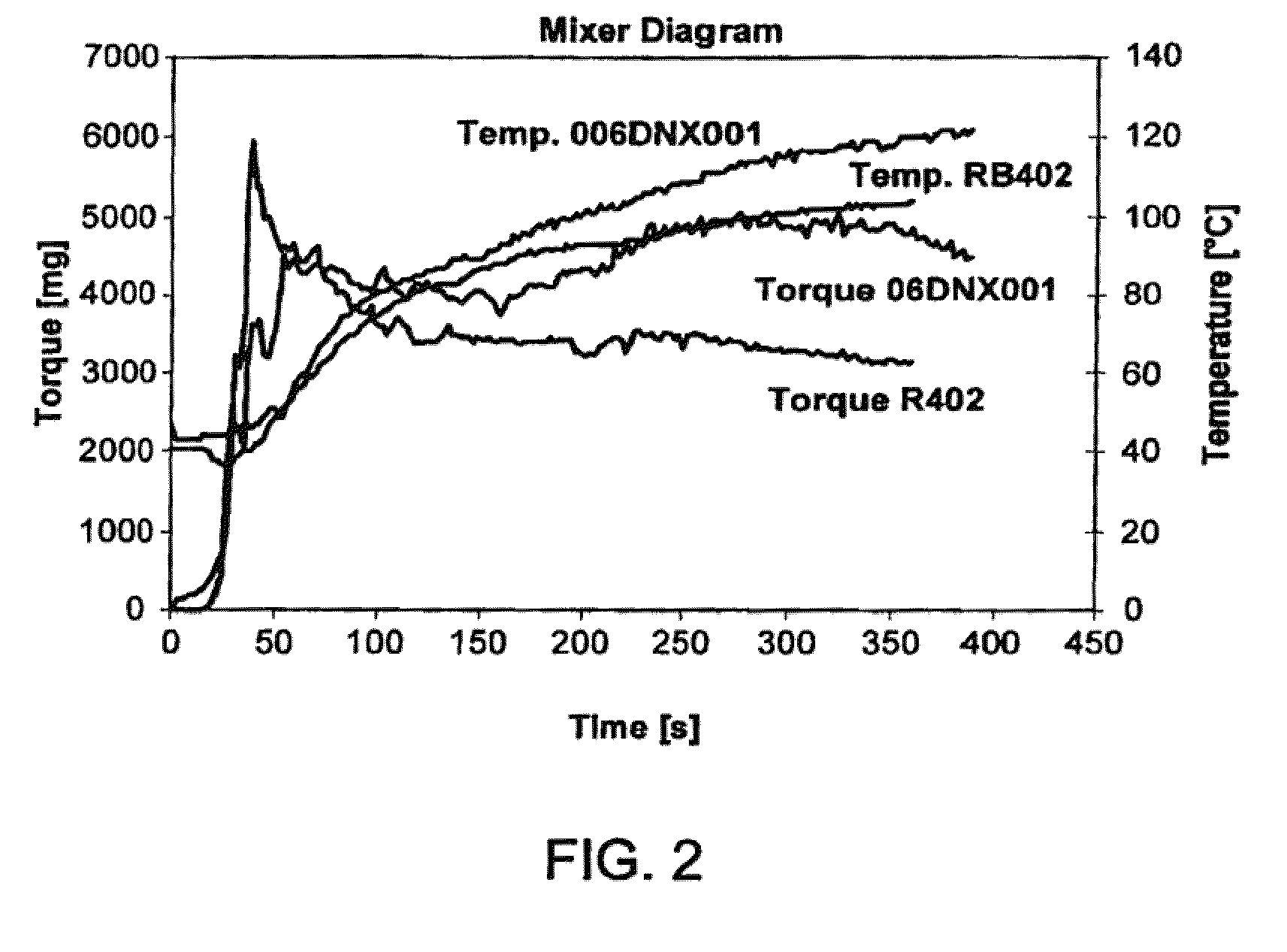Arborescent polymers and process for making same
a technology of arborescent polymers and polymers, applied in the field of arborescent polymers and to a process for making same, can solve the problems of reduced production rate, high cost and unforgiving current synthesis of new butyl polymers, and limited development of novel butyl-based elastomers, etc., and achieve high glass transition temperature (tg)
- Summary
- Abstract
- Description
- Claims
- Application Information
AI Technical Summary
Benefits of technology
Problems solved by technology
Method used
Image
Examples
example 1
06DNXOO1
[0088]Polymerization is carried out in a 3 dm3 round shape baffled glass reactor. The reactor is equipped with a glass stirrer rod (mounted with a crescent shaped Teflon impeller) and a thermocouple. To the reactor are added 0.35 grams of pMeOCumSt, 900 cm3 hexane (measured at room temperature), 600 cm3 methyl chloride (measured at −95° C.), 2 cm3 di-tert-butylpyridine (measured at room temperature) and 240 cm3 isobutylene (measured at −95° C.). Polymerization is started at −95° C. by addition of a pre-chilled mixture of 6 cm3 TiCl4 and 20 cm3 hexane (both measured at room temperature). After 120 minutes of polymerization, a mixture of 236 cm3 isoprene (measured at room temperature), 150 cm3 methyl chloride (measured at −95° C.) and 0.5 cm3 di-tert-butylpyridine (measured at room temperature) is added. Upon the addition of the isoprene charge, the viscous solution turns into a two phase system. The solution is brought back to a viscous solution by the addition of 150 cm3 hex...
example 2
06DNX130
[0096]Polymerization is carried out in a 3 dm3 round shape baffled glass reactor. The glass reactor is equipped with a glass stirrer road (mounted with a crescent shaped Teflon impeller) and a thermocouple. To the reactor are added 0.70 grams of pMeOCumSt, 900 cm3 hexane (measured at room temperature), 600 cm3 methyl chloride (measured at −92° C.), 2 cm3 di-tert-butylpyridine (measured at room temperature) and 240 cm3 isobutylene (measured at −92° C.). Polymerization is started by the addition of a pre-chilled mixture of 6 cm3 TiCl4 and 30 cm3 hexane (both measured at room temperature). After 45 minutes of polymerization, a pre-chilled mixture of 70 cm3 isoprene, 0.5 cm3 di-tert-butylpyridine, and 0.90 cm3 dimethyl acetamide (all measured at room temperature) is added. To accelerate the reaction a 1.0 molar solution of ethyl aluminum dichloride in hexane is added in 10 cm3 increments at 45.5, 48 and 50.5 minutes. Addition of the last increment resulted in 4° C. temperature r...
example 3
05DNX150
[0105]This is a comparative example designed to determine the behavior of the arborescent PIB core. Polymerization is carried out in a 5 dm3 round shape baffled glass reactor. The glass reactor is equipped with a glass stirrer road (mounted with a crescent shaped Teflon impeller) and a thermocouple. To the reactor are added 0.7 grams of pMeOCumSt, 1800 cm3 methyl-cyclohexane (measured at room temperature), 1200 cm3 methyl chloride (measured at −95° C.), 4 cm3 di-tert-butylpyridine (measured at room temperature) and 480 cm3 isobutylene (measured at −95° C.). Polymerization is started at −93° C. by the addition of a pre-chilled mixture of 11 cm3 TiCl4 and 40 cm3 methyl-cyclohexane (both measured at room temperature). After 85 minutes of polymerization, a mixture of 100 cm3 isoprene (measured at room temperature), 250 cm3 of isobutylene (measured at −95° C.), and 250 cm3 methyl-cyclohexane (measured at room temperature) is added. Polymerization is terminated at 122 minutes by t...
PUM
| Property | Measurement | Unit |
|---|---|---|
| Tg | aaaaa | aaaaa |
| Tg | aaaaa | aaaaa |
| Tg | aaaaa | aaaaa |
Abstract
Description
Claims
Application Information
 Login to View More
Login to View More - R&D
- Intellectual Property
- Life Sciences
- Materials
- Tech Scout
- Unparalleled Data Quality
- Higher Quality Content
- 60% Fewer Hallucinations
Browse by: Latest US Patents, China's latest patents, Technical Efficacy Thesaurus, Application Domain, Technology Topic, Popular Technical Reports.
© 2025 PatSnap. All rights reserved.Legal|Privacy policy|Modern Slavery Act Transparency Statement|Sitemap|About US| Contact US: help@patsnap.com



